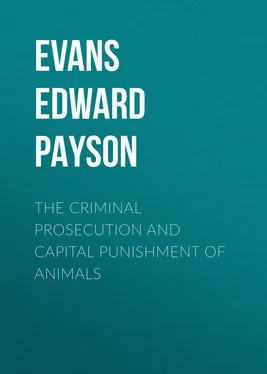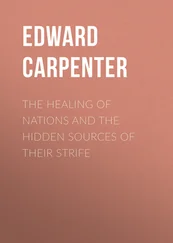Edward Evans - The Criminal Prosecution and Capital Punishment of Animals
Здесь есть возможность читать онлайн «Edward Evans - The Criminal Prosecution and Capital Punishment of Animals» — ознакомительный отрывок электронной книги совершенно бесплатно, а после прочтения отрывка купить полную версию. В некоторых случаях можно слушать аудио, скачать через торрент в формате fb2 и присутствует краткое содержание. Жанр: foreign_antique, foreign_prose, на английском языке. Описание произведения, (предисловие) а так же отзывы посетителей доступны на портале библиотеки ЛибКат.
- Название:The Criminal Prosecution and Capital Punishment of Animals
- Автор:
- Жанр:
- Год:неизвестен
- ISBN:нет данных
- Рейтинг книги:5 / 5. Голосов: 1
-
Избранное:Добавить в избранное
- Отзывы:
-
Ваша оценка:
- 100
- 1
- 2
- 3
- 4
- 5
The Criminal Prosecution and Capital Punishment of Animals: краткое содержание, описание и аннотация
Предлагаем к чтению аннотацию, описание, краткое содержание или предисловие (зависит от того, что написал сам автор книги «The Criminal Prosecution and Capital Punishment of Animals»). Если вы не нашли необходимую информацию о книге — напишите в комментариях, мы постараемся отыскать её.
The Criminal Prosecution and Capital Punishment of Animals — читать онлайн ознакомительный отрывок
Ниже представлен текст книги, разбитый по страницам. Система сохранения места последней прочитанной страницы, позволяет с удобством читать онлайн бесплатно книгу «The Criminal Prosecution and Capital Punishment of Animals», без необходимости каждый раз заново искать на чём Вы остановились. Поставьте закладку, и сможете в любой момент перейти на страницу, на которой закончили чтение.
Интервал:
Закладка:
In his “First Counsel” Chassenée not only treats of methods of procedure, and gives forms of plaints to be drawn up and tendered to the tribunal by the injured party, as well as useful hints to the pettifogger in the exercise of his tortuous and tricky profession, but he also discusses many legal principles touching the jurisdiction of courts, the functions of judges, and other characteristic questions of civil, criminal, and canonical law. Animals, he says, should be tried by ecclesiastical tribunals, except in cases where the penalty involves the shedding of blood. An ecclesiastical judge is not competent in causa sanguinis , and can impose only canonical punishments, although he may have jurisdiction in temporal matters and punish crimes not involving a capital sentence. [ Nam judex ecclesiasticus in causa sanguinis non est competens judex, licet habeat jurisdictionem in temporalibus et possit crimina poenam sanguinis non existentia ( exigentia is obviously the correct reading) castigare . Cons. prim. IV. § 5.] For this reason the Church never condemned heretics to death, but, having decided that they should die, gave them over to the secular power for formal condemnation, usually under the hollow and hypocritical pretence of recommending them to mercy. In the prosecution of animals the summons was commonly published from the parish pulpit and the whole judicial process bore a distinctively ecclesiastical character. In most cases the presiding judge or official was the vicar of the parish acting as the deputy of the bishop of the diocese. Occasionally the curate officiated in this capacity. Sometimes the trial was conducted before a civil magistrate under the authority of the Church, or the matter was submitted to the adjudication of a conjurer, who, however, appointed two proctors to plead respectively for the plaintiff and the defendant and who rendered his verdict in due legal form. Indeed, the word “conjurer” seems to have been used as a popular designation of the person, whether priest or layman, who exercised judicatory functions in such trials, probably because, as a rule, the sentence could be executed only by conjuration or the invocation of supernatural aid.
Another point, which strikes us very comically, but which had to be decided before the trial could proceed, was whether the accused were to be regarded as clergy or laity. Chassenée thinks that there is no necessity of testing each individual case, but that animals should be looked upon as lay persons. This, he declares, should be the general presumption; but if any one wishes to affirm that they have ordinem clericatus and are entitled to benefit of clergy, the burden of proof rests upon him and he is bound to show it ( deberet estud probare ). Probably our jurist would have made an exception in favour of the beetle, which entomologists call clerus ; it is certain, at any rate, that if a bug bearing this name had been brought to trial, the learning and acuteness displayed in arguing the point in dispute would have been astounding. We laugh at the subtilties and quiddities of mediæval theologians, who seriously discussed such silly questions as the digestibility of the consecrated elements in the eucharist; but the importance attached to these trivialities was not so much the peculiarity of a single profession as the mental habit of the age, the result of scholastic training and scholastic methods of investigation, which tainted law no less than divinity. Nevertheless the ancillary relations of all other sciences and disciplines to theology render the latter chiefly responsible for this fatal tendency.
Chassenée also makes a distinction between punitive and preventive purposes in the prosecution of animals, between inflicting penalties upon them for crimes committed and taking precautionary measures to keep them from doing damage. By this means he seeks to evade the objection, that animals are incapable of committing crimes, because they are not endowed with rational faculties. He then proceeds to show that “things not allowable in respect to crimes already committed are allowable in respect to crimes about to be committed in order to prevent them.” Thus a layman may not arrest an ecclesiastic for a delict fully consummated, but may seize and detain him in order to hinder the consummation of a delict. In such cases, an inferior may coerce and correct a superior; even an irrational creature may put restraint upon a human being and hold him back from wrong-doing. In illustration of this legal point he cites an example from Holy Writ, where “Balaam, the prophet and servant of the Most High, was rebuked by a she-ass.”
Chassenée endeavours to clinch his argument as usual by quoting biblical texts and adducing incidents from legendary literature. The province of zoö-psychology, which would have furnished him with better material for the elucidation of his subject, he leaves untouched, simply because it was unknown to him. If crime consists in the commission of deeds hurtful to other sentient beings, knowing such actions to be wrong, then the lower animals are certainly guilty of criminal offences. It is a well-established fact, that birds, beasts and insects, living together in communities, have certain laws, which are designed to promote the general welfare of the herd, the flock or the swarm, and the violation of which by individual members they punish corporally or capitally as the case may require. It is likewise undeniable, that domestic animals often commit crimes against man and betray a consciousness of the nature of their acts by showing fear of detection or by trying to conceal what they have done. Man, too, recognizes their moral responsibility by inflicting chastisement upon them, and sometimes feels justified in putting incorrigible offenders, a vicious bull, a thievish cat or a sheep-killing dog, summarily to death. Of course this kind of punishment is chiefly preventive, nevertheless it is provoked by acts already perpetrated and is not wholly free from the element of retributive justice. Such a proceeding, however, is arbitrary and autocratic, and if systematically applied to human beings would be denounced as intolerable tyranny. Chassenée insists that under no circumstances is a penalty to be imposed except by judicial decision — nam poena nunquam imponitur, nisi lex expresse dicat – and in support of this principle refers to the apostle Paul, who declares that “sin is not imputed when there is no law.” He appears to think that any technical error would vitiate the whole procedure and reduce the ban of the Church to mere brutum fulmen . If he lays so great stress upon the observance of legal forms, which in the criminal prosecution of brute beasts strike us as the caricature and farce of justice, it is because he deems them essential to the effectiveness of an excommunication. The slightest mispronunciation of a word, an incorrect accentuation or false intonation in uttering a spell suffices to dissolve the charm and nullify the occult workings of the magic. The lack of a single link breaks the connection and destroys the binding force of the chain; everything must be “well-thought, well-said and well-done,” not ethically, but ritually, as prescribed in the old Avestan formula: humata hûkhta huvarshta . All the mutterings and posturings, which accompany the performance of a Brahmanical sacrifice, or a Catholic mass, or any other kind of incantation have their significance, and none of them can be omitted without marring the perfection of the ceremonial and impairing its power. An anathema of animals pronounced in accordance with the sentence passed upon them by a tribunal, belongs to the same category of conjurations and is rendered nugatory by any formal defect or judicial irregularity.
Sometimes the obnoxious vermin were generously forewarned. Thus the grand-vicars of Jean Rohin, Cardinal Bishop of Autun, having been informed that slugs were devastating several estates in different parts of his diocese, on the 17th of August, 1487, ordered public processions to be made for three days in every parish, and enjoined upon the said slugs to quit the territory within this period under penalty of being accursed. On the 8th of September, 1488, a similar order was issued at Beaujeu. The curates were charged to make processions during the offices, and the slugs were warned three times to cease from vexing the people by corroding and consuming the herbs of the fields and the vines, and to depart; “and if they do not heed this our command, we excommunicate them and smite them with our anathema.” In 1516, the official of Troyes pronounced sentence on certain insects ( adversus brucos seu eurucas vel alia non dissimilia animalia, Gallicè urebecs , probably a species of curculio ), which laid waste the vines, and threatened them with anathema, unless they should disappear within six days. Here it is expressly stated that a counsellor was assigned to the accused, and a prosecutor heard in behalf of the aggrieved inhabitants. As a means of rendering the anathema more effective, the people are also urged to be prompt and honest in the payment of tithes. Chassenée, too, endorses this view, and in proof of its correctness refers to Malachi, where God promises to rebuke the devourer for man’s sake, provided all the tithes are brought into the storehouse.
Читать дальшеИнтервал:
Закладка:
Похожие книги на «The Criminal Prosecution and Capital Punishment of Animals»
Представляем Вашему вниманию похожие книги на «The Criminal Prosecution and Capital Punishment of Animals» списком для выбора. Мы отобрали схожую по названию и смыслу литературу в надежде предоставить читателям больше вариантов отыскать новые, интересные, ещё непрочитанные произведения.
Обсуждение, отзывы о книге «The Criminal Prosecution and Capital Punishment of Animals» и просто собственные мнения читателей. Оставьте ваши комментарии, напишите, что Вы думаете о произведении, его смысле или главных героях. Укажите что конкретно понравилось, а что нет, и почему Вы так считаете.












